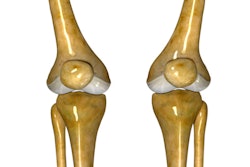A comparison of MR imaging techniques shows the physical impact of playing basketball may vary for different cartilage regions in the knee, and those same techniques may help detect subtle cartilage changes, say researchers from California.
The study from researchers at Stanford University and the University of California, San Francisco also suggests there may be beneficial effects on tibiofemoral cartilage and potentially damaging effects on patellofemoral articular cartilage among young, asymptomatic athletes who play a high-intensity level of basketball.
"Much work has been done in investigating the effects of physical activity on articular cartilage health," said lead study author Melissa Vogelsong, a radiology student at Stanford University. "However, many of these previous studies have been limited by imaging technologies available."
In her presentation at the recent International Society for Magnetic Resonance in Medicine (ISMRM) annual meeting in Montreal, Vogelsong noted that traditional MRI allows for the visualization of morphological damage, which often occurs late in the osteoarthritic process.
Biochemical markers
Several biochemical markers, such as proteoglycan and collagen damage, are known to identify early signs of osteoarthritis. "Therefore," Vogelsong said, "we chose to utilize three of these [MR imaging] techniques -- T1ρ, T2 mapping, and sodium MRI -- in order to assess these biochemical properties of cartilage."
The mapping of T2 relaxation times has shown to represent collagen structure and water content, while sodium MRI is used to visualize proteoglycan content through the attraction between positively charged sodium ions and negatively charged glycosaminoglycans.
The benefit of T1ρ imaging "is still slightly unclear," Vogelsong added. "We have seen correlations between T1ρ and T2 [imaging]. However, [T1ρ] has been proposed as a more sensitive marker for early cartilage change than T2."
In this study, researchers used the three MR imaging techniques to assess articular cartilage health among Division I collegiate basketball players before and after their five-month season. The secondary objective was to compare medical pathologies seen in the athletes' knees prior to and following the season.
The researchers prospectively enrolled 21 basketball players (10 men and 11 women, ranging in age from 18 to 22 years) who were imaged in the sagittal plane using a 3-tesla MRI scanner (Signa Excite, GE Healthcare) and an eight-channel proton (for T2 and T1ρ imaging) or custom sodium coil.
T2 and T1ρ images
T2 images were obtained using a 2D fast spin-echo (FSE) sequence, while T1ρ images were acquired using a prototype spoiled gradient-echo sequence. A fast gradient-spoiled sequence using 3D cones was used to obtain sodium images. Routine 2D FSE images with fat suppression using axial and sagittal proton density weighting and sagittal T2 weighting also were obtained.
Two independent observers then manually outlined 14 regions of interest and from the results measured for sodium signal intensity or T1ρ and T2 relaxation times. In addition, a musculoskeletal radiologist and an orthopedic surgeon evaluated 2D FSE images for patellar and quadriceps tendinopathy, ligament and meniscal injury, articular cartilage health, and bone marrow edema.
A review of the images found pathologies were seen frequently in the patellar region, with signal changes or defects in patellar articular cartilage in 10 and 13 athletes for the pre- and postseason, respectively. In addition, patellar bone marrow edema was seen in 10 and 16 athletes for the pre- and postseason, respectively.
Athletes' ailments
The athletes also tended to have mild patellar and quadriceps tendinopathy, mild edema surrounding ligaments, and either no or mild meniscal signal both before and after the season, with little change over the course of the season.
In addition, the study found that T1ρ relaxation times decreased significantly in all regions, while T2 relaxation times increased significantly in the lateral femur, medial femur, and medial tibia.
"Given the proposed correlation between T1ρ and fixed-charge density, the decreases may signify increased deposition of proteoglycans, leading to increased interactions between water molecules and their local environment," Vogelsong said. "We presume that this was the result of sustained stress on the cartilage throughout the course of the season."
The results suggest "this sustained period of high-intensity activity among this population of elite athletes may have increased proteoglycan content in the tibiofemoral cartilage," Vogelsong concluded. "However, it also suggests that there may have been degradation of the collagen, possibly a decrease in proteoglycan content in the patella, as well as an increase in the number of several other clinical pathologies."
Future research
The next step is to further evaluate the observed changes, looking for associations between pre-existing clinical conditions or between the times of an athlete's last activity and the patterns of cartilage change.
"Ultimately," Vogelsong said, "it is our hope that these techniques will allow for early disease detection, as well as assessment of drugs and therapies designed to slow or prevent the progression of osteoarthritis."
Note: GE Healthcare has provided grant support for related research at the Global Applied Sciences Laboratory in Menlo Park, CA, which contributed to this study.



.fFmgij6Hin.png?auto=compress%2Cformat&fit=crop&h=100&q=70&w=100)




.fFmgij6Hin.png?auto=compress%2Cformat&fit=crop&h=167&q=70&w=250)











